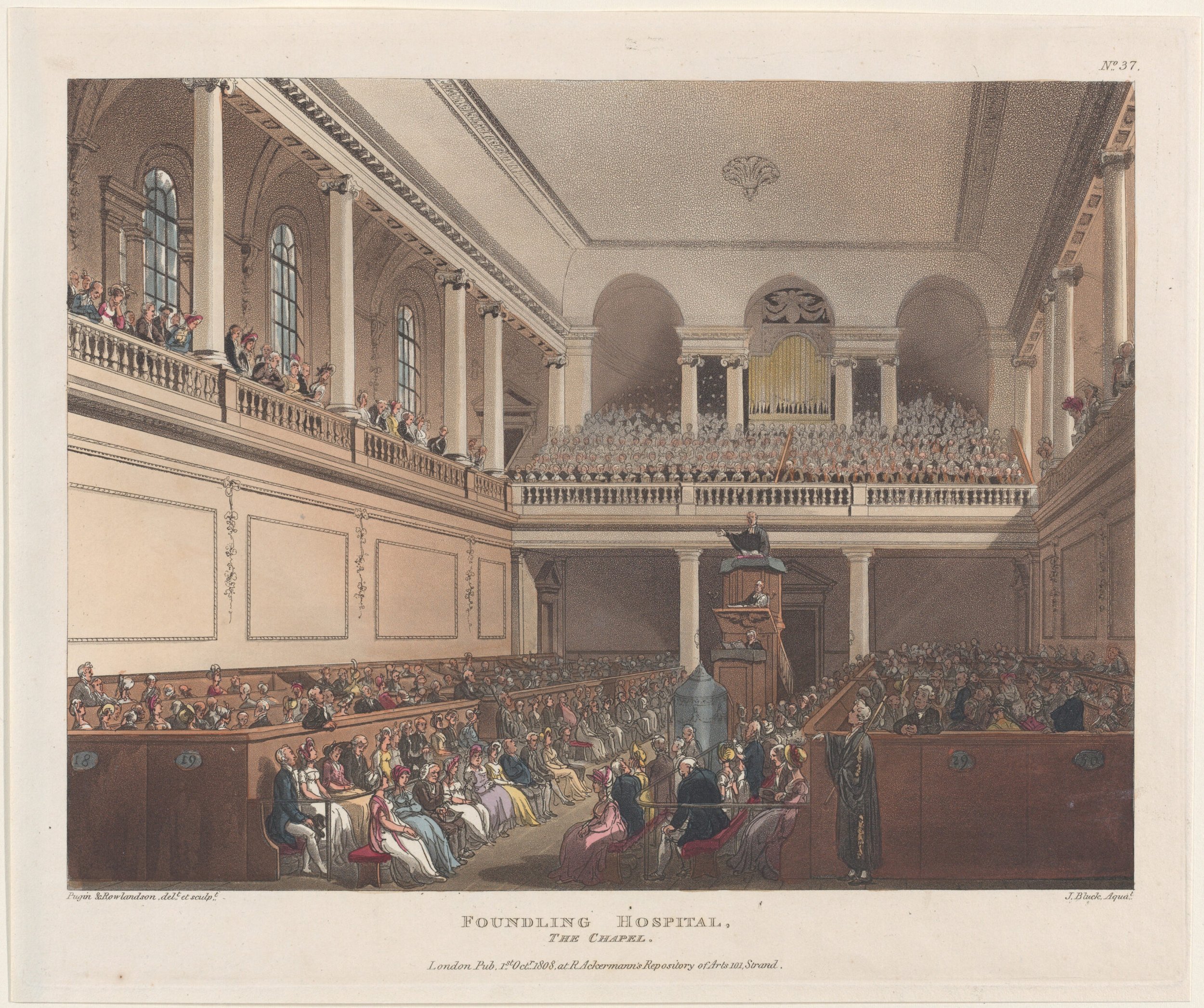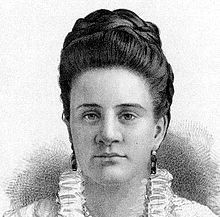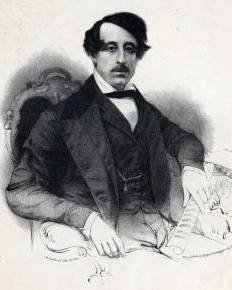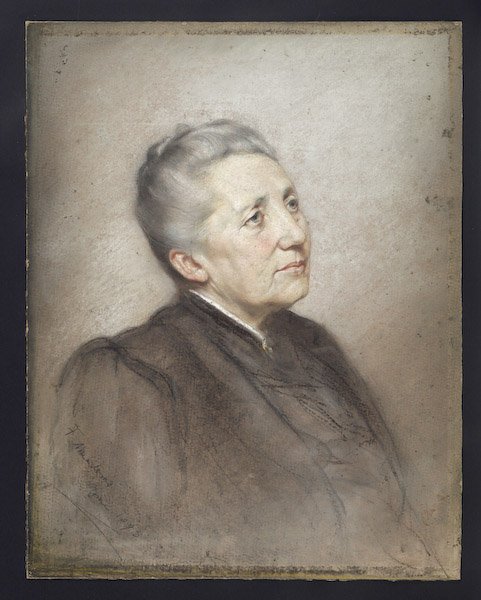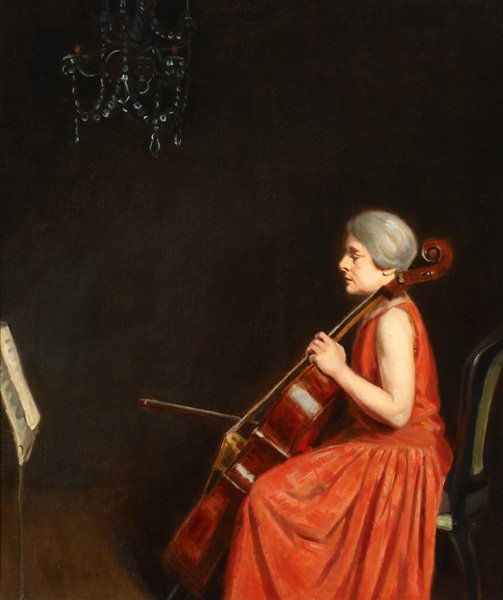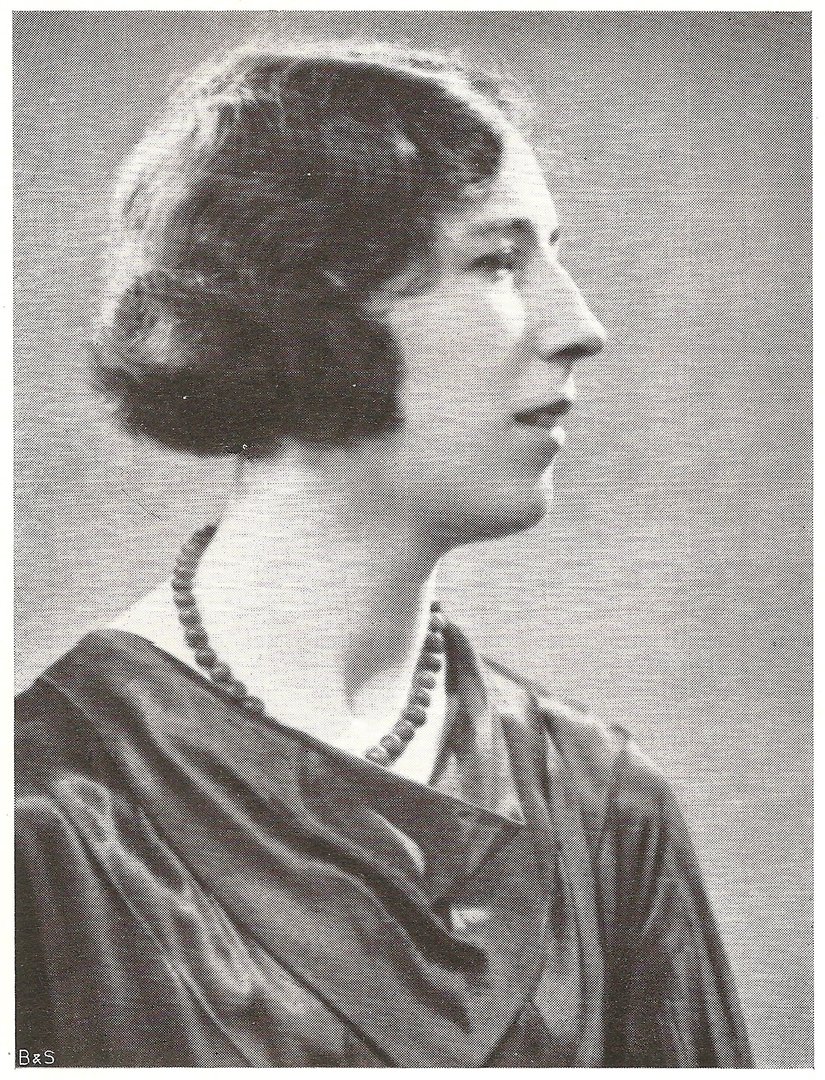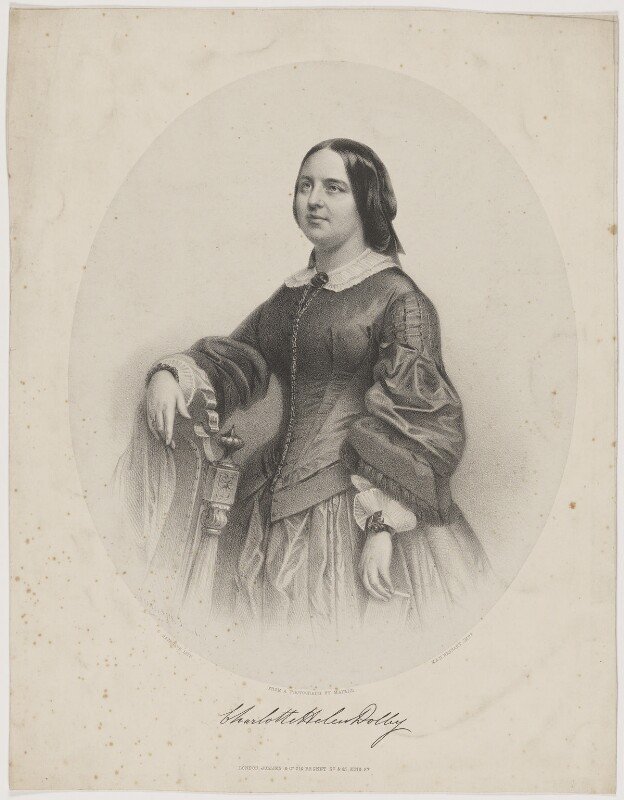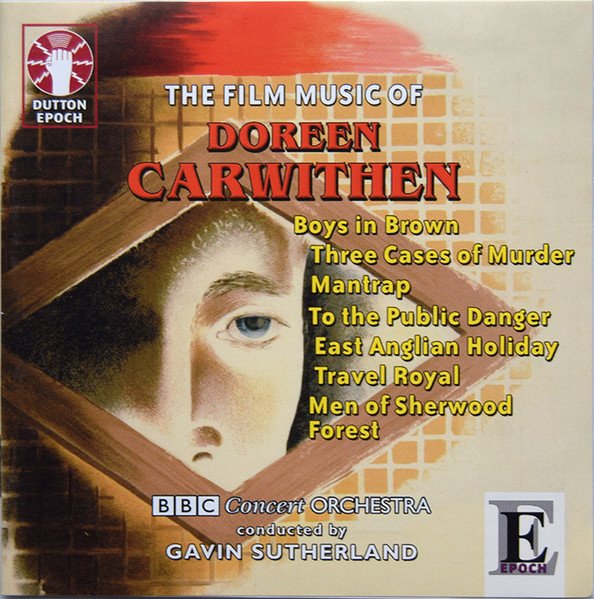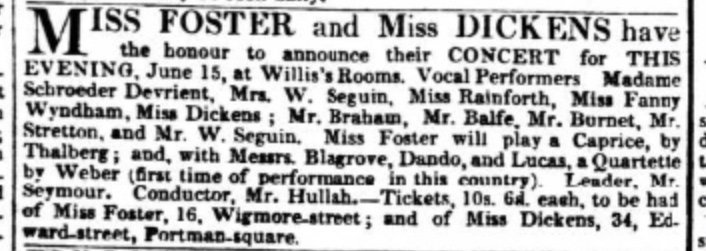Writing Women In: Catherine Lloyd, and the year was 1826
Catherine Lloyd joined the Academy in 1826 under the articles scheme. This allowed talented musicians who could not afford the fees to study at RAM, allowing the institution to take at least part (and usually all) of their professional fees as payment for their education. Catherine was to be articled for three years; in the end, it was for only two. Underneath the slightly convoluted negotiations undertaken on her behalf by her guardian James Taylor and the Academy that are chronicled in the committee minutes one can sense a musician with little control and a growing sense of desperation of what is being asked of her. It’s interesting, too, to see the difference in her treatment from that of her contemporaries the Childe sisters.
It all started rather well – Catherine was going to attend the Academy as an extra student, articled for three years. She appeared in external concerts, for which the Committee negotiated her fee, and she was busy within the institution as well. She sang several Handel arias (a composer for whom she gained a particularly high reputation) in Academy concerts at Hanover Square Concert Rooms, as well as some Italian opera. She even won second prize for singing in 1827. But then in 1828, there was a request from James Taylor that she be released from her articles, to remain a student of the Academy under the same conditions as those who were non-articled. The Committee appear not to have taken this well. They demand that Miss Lloyd pays full fee for the two years she has already had, as well as paying in advance for future studies.
It's worth remembering here that articles meant that a singer had little control over what or where she sang. She could be asked to sing full roles, or take part in a concert at short notice. And while the Academy was often careful about ensuring that engagements did not harm the voices of its young students, the balance of this with the prospect of fees for the financially-straitened institution was not always in favour of the musician. One has to wonder if Miss Lloyd found it all a bit much. It is also noticeable that the demand for her to make good her debt was quite different from the tone adopted around the Childe sisters’ inability to pay.
An important factor in Miss Lloyd’s request to be freed from her articles was doubtless her engagement at the Foundling Hospital: ‘the Secretary of the Foundling Hospital acquaint[s] the Committee that the Governor of that institution had resolved to engage Miss Lloyd to sing in their chapel, at a salary of forty guineas per annum and that she would be required to commence her duties on Sunday next.’ This of course meant that Catherine would not be as available to fulfil any other performing obligations, both due to time but also vocal resilience. The committee, sensing fee settlement possibilities, approved the position, and thereupon expended rather a lot of energy chasing Miss Lloyd for a portion of her income.
It is not clear when Catherine left the Academy, but between 1828 and 1832 she had a busy performing schedule around the country, to extremely good reviews. Frequent mention was made of her ‘rich, full-toned’ sound, and her extensive compass. She was engaged by the Concerts of Ancient Music in 1831, and the papers reported that ‘Miss Lloyd’s voice is peculiarly fine, its tones are dulcet, rich and powerful. Her intonation is perfect, and she imparted to the air allotted to her great expression and feeling. She appears to understand the true style of Handel, which no doubt has been imparted to her from her instructor. This young lady will prove a valuable acquisition to these concerts.’ She also appeared in Brighton, where the review was even more enthusiastic, although noting some room for improvement:
“The principal attraction of the vocalist was Miss Lloyd. She sang the scena “Softly sighs” from Der Freischützto the delight of all present. The tender pathos which she infused into the ballad “Alice Gray” won the enthusiastic plaudits of the audience; and she was not less successful in the aria of Rossini, “Di piacer”. Her voice is of a magnificent description; it is clear, full-toned, and remarkably mellifluous. Her taste too is excellent. In execution she is not so finished; great improvement in that particular has, however, taken place since she visited Brighton last year: by practice she may make herself thoroughly mistress of that essential to complete the finished singer.”
Unfortunately, the usual course of events put a stop to this promising career. At some point in the early 1830s Miss Lloyd became Mrs Johnson and retired from the public stage. Any activities she may have undertaken in private musical spheres remain invisible. The upside to her marriage, however, was that her husband, clearly a good earner, was able to clear the remaining debt to the Academy of £23.2.0, and Miss Lloyd finally exits the minutes of the Committee of Management. It’s unfortunate that a musician with such obvious talent also exits music history. If she had been able to continue as a singer, she may even have made Henry Chorley’s shortlist of eminent musicians forty years later.
Writing Women In: Ann Childe, and the year was 1825
When the Academy started in 1822, English society at large was shocked. While it was great to have a musical education college in the country, what on earth were they thinking, taking in girls and boys at the same time?! Imagine what would happen!
So the Academy, with its 1822 head on, created separate departments for female and male students. That should do it!
Except of course, teenagers will be teenagers, however, no matter what era, and in his memoirs, ex-student Lindley Nunn recalled the futility of it all: ‘It will hardly astonish my readers to learn that matrimonial alliances were the rule rather than the exception, brought together as the students were – meeting daily in the common Entrance Hall, at Rehearsals and Concerts, and not infrequently elsewhere (contrary to the rules, I am afraid).’ Singers Ann Childe (1811-1888) and Arthur Edward Seguin (known as Edward) (1809-1852) were a particularly well-known and successful example of this (despite having to overcome a particularly salacious episode of bad behaviour in Edward’s studentship). Both Ann and Edward were vocal stars of the Academy, probably the one thing that kept them in the Academy despite the afore-mentioned bad behaviour and, on Ann’s part, an apparent complete inability on the part of her family to pay the fees.
Arthur Edward Seguin
Ann, the eldest of three Childe sisters to enter the Academy, passed the audition for her studies as a singer in 1825, alongside Emily, who chose piano for her principal study. Within a year, Ann’s path was clear. She sang in almost every concert, often appearing as a soloist multiple times within the same event, as well as performing in ensembles and duos. The core of her repertoire seems to have been Italian opera, with composers such as Rossini, Cimarosa and Pacini being favourites, while the more ‘English’ rep such as Crotch and Handel being less frequent. By 1827 she was much in demand outside the Academy, not just through requests from Academy teachers for her appearance in their external concerts, but also through institutions such as the Philharmonic Society and Philanthropic Society. All of these requests had to go through the Academy’s Committee of Management, who acceded to every request, although interestingly, the Philanthropic Society’s approval was tempered with the statement that the Committee could not ‘approve of her singing the air assigned to her in the 1st part.’
The Committee’s willingness to allow such constant absence for external engagements was clearly a complicated mix of pride in having a student who was doing so well and a desire to recoup the fee debt that the Childe family were accruing for the two sisters. Ann and Emily’s father James Warren Childe was a painter whose income clearly did not stretch to the required * guineas per year, and the Committee minutes are full of accounts of letters and conversations with him, trying to gauge his ability to pay the fees and suggesting a timeline of payments. At no point was it suggested that the sisters should leave, a testament to their ability and to Ann’s growing fame.
A particularly tricky episode for Ann in the Academy’s history was around its complete break with ex-harp teacher and fraudster Charles-Nicholas Bochsa. I’ve written before about his complicated and rather fast-and-loose relationship with both music and the law that resulted in his dismissal from the Academy, so suffice here to recount his attempt to purloin Ann and other students for his opera company. His first approach to the committee for their services was above board; in 1829 he requested the ‘services of Miss Childe and Brizzi for 6 Italian operas to be given at the theatre at Brighton between 2nd and 22nd November, he having already engaged Miss Bellchambers and Mr E Seguin and Mr A Sapio for the said performances.’ Ann’s father was ‘particularly anxious’ for her to accept the engagement, probably because of the accompanying fee – Ann herself, however, seems to have been less enthusiastic. Indeed, she refused outright to sing the title role in Vaccai’s opera Giulietta et Romeo, and once it was discovered that the engagement was a cover for inveigling the students to leave the Academy altogether, all concerned gave up the whole idea with disgust, citing the ‘malicious and unprincipled designs of Mr Bochsa.’
In all these performances, both within and outside the Academy, it is notable just how many included the services of Edward Seguin as well, and eventually the inevitable happened. The impending nuptials are referred to rather coyly in the Committee minutes, when they advise Ann’s father that they can’t allow her performing fees to pay for sister Maria’s studies, as ‘Miss Ann Childe’s situation in life may very soon be altered whereby her father will not have any claim or control over her services.’ Ann and Edward married in 1832. They continued to perform together in concert, and From 1834 to 1836, she sang in the Italian opera season at the King's Theatre, Haymarket, continuing the repertoire that had earned her such good reviews as a student. Her eldest child Edward was born in 1837 – he too would become a singer – and the following year, on the invitation of American impresario John Lester Wallack, the family set sail for New York, where they would be based for the rest of their lives.
The couple debuted in America in The Barber of Seville in 1839, but it was not long before they founded their own opera company, the Seguin Troupe, which found success across North America. Anne’s obituary summed up this chapter of her life:
“In February 1839 Mrs Seguin made her debut here as Rosina in The Barber of Seville, with De Begnis as Figaro and Mr Seguin as the Doctor. Both Mr and Mrs Seguin were strongly identified with English opera here for many years, but their distinguishing success was achieved in the Bohemian Girl which was first brought out here in 1844 at the Park Theatre with Mrs Seguin as Arline and Mr Seguin as Devilshoof. The opera was beautifully put upon the stage, and the ballet in the first scene, since generally omitted, was made specially beautiful and attractive. It met with extraordinary success not only in New York but throughout the country generally. Mrs Seguin created a sensation that has bever been excelled in lyric art. She sang the part of the Gypsy more than 1,000 times. Mrs Seguin also sang in Amelia, La Sonnambula, Cinderella and various other operas, always achieving unparalleled success.”
This success lasted until Edward’s early death from tuberculosis in 1852. Anne immediately retired from the stage, although she remained active backstage and in her musical salon, as well as teaching. She was an American point of contact for many Academy ex-students who toured in the country – Anna Bishop was one old friend who was delighted to remake her acquaintance when she came to New York. Anne Childe died in 1888, leaving a fortune of over $100,000, survived only by one daughter and a grandson.
Song dedicated to Anne Childe
Writing Women In: Andalusia Grant, and the year was 1824
Only eleven new students joined the Royal Academy of Music community in 1824. The institution, now in its second year, was already finding its finances squeezed, and almost all the students from the previous year were still in situ. In this year, the boys were clearly chosen for their ability to swell the ranks of the orchestra – they comprised a violinist, a bass player and three flutes – while of the six girls, two went on to teach (very successfully), two retired on marriage (including the youngest of the famed Bellchambers sisters), and the remaining two became the extremely well-known Madame Anna Bishop and Lady Molesworth. I have written in other places of Anna Bishop and her colourful life, so today’s focus is on Andalusia Grant, also known in later life as Mrs Temple West and eventually as Lady Molesworth.
Andalusia Grant was born in Ireland in December 1809, and thus was fourteen when she entered the Academy in June 1824. Her obituary in 1888 wrote that ‘her father, Mr. Bruce Carstairs, was a Scotchman, her mother was of Spanish descent. Their means were small, and the education of their child would have been a difficulty but for her early shown musical gifts. These were cultivated at the Royal Academy of Music, and it was hoped that a brilliant career on the lyric stage or in the concert-room would be the result.’ The fees were rescinded for Grant, who later would donate £300 to the Academy as acknowledgement of having ‘received her gratuitous professional education in the institution.’ Her principal study was singing, for which she gained a prize in 1825. She also of course had the extra subjects such as harmony that meant that like her older contemporary Susannah Collier, she was permitted to inscribe some of her compositions into the community volumes (although their brevity suggests that this was not where her main interests lie!).
GB-Lam MS 204, Vol II, Student Compositions. Royal Academy of Music Special Collections.
Grant sang in many of the Academy monthly exhibitions from 1825 to 1827, always to good reviews. As was the norm for singers, she started in ensemble performances such as the sextet from Don Giovanni, moving on to duets and eventually solos. In November 1826 she sang an aria from Mozart’s La Clemenza di Tito and a serenata by Ferdinando Paer, in which she ‘displayed a mingled strength and melody of voice, guided by a pure taste, and combined with a degree of ease and spirit, which hold forth more than a promise of first-rate excellence.’ The Handel she performed the following month was approved of for its ‘very chaste and effective manner’. By 1827, she was taking leave of absence from the Academy to sing at Covent Garden, where again the reviews were excellent. The Mozart she sang in June ‘was rapturously encored; her voice is remarkably powerful and sweet, aided by science and taste; and she may be considered to have made, what is termed a complete hit.’
Andalusia Grant left the Academy in December 1827. The next few years were busy performing-wise, both in Britain and abroad. She was a regular at the Drury Lane Theatre, where she appeared in new and lighter works such as John Davy’s Rob Roy Macgregor and James Cobb’s Paul and Virginia, a Romeo and Juliet-esque story that included shipwreck and exotic islands. One review in particular described her both physically and vocally:
“In person Miss Grant is tall and elegant; her face is well formed, her head well set, and ornamented with a quantity of auburn hair. She appears to be about eighteen years of age. Her voice, which is the more important point with a singer, is a soprano, generally clear and fine, without, however, very great compass. Her upper notes are very rich, but lower in the scale her tones become thick and husky. She has, however, a composite knowledge of music and most scientific execution, joined to great skill in the management of her voice. Upon the whole she deserves the favourable reception she met with. Her acting was not goof, and as this is a matter to which since the excellence displayed by Miss Paton the public expect that a singer will carefully attend, she will do well to make it her particular study.”
This lack of stagecraft appears in other reviews and is an indication of a lack in the syllabus of the Academy at the time.
Grant’s success continued over the next few years, in both public and private performances. Then, in 1831, ‘whilst she was trying a song at the house of Mr. Loder, the music-master, at Bath, Mr. Temple West, an elderly virtuoso, who had come in for his violoncello lessons, caught the tones, looked over the curtain of the glass door, saw the singer, and asked for an introduction.’ Little is known of their relationship, which was cut short by Temple West’s death in 1839. Six years later, Grant married William Molesworth of the Pencarrow seat in Cornwall. This marriage was to set the tone of the rest of Andalusia’s life, as it afforded her both the income and the space to host salons, mount concerts, and preside over diverse social gatherings of many hues. This social life has borne much scrutiny over the years, especially the famous men who dined at her table, such as Charles Dickens, Arthur Sullivan and Napoleon III. She has come under fire for driving her husband’s parliamentary career, although this comes with an admission that had she not done so, it is unlikely that the Pencarrow MP would have risen to Cabinet rank. His family had not been in favour of the marriage, probably in part given the whirlwind courtship of three months, but certainly also because of Lady Molesworth’s background – as her obituary observed, ‘she was not one of those born In the purple’ – and her age, which was not conducive to producing an heir.
Pencarrow House.
William Molesworth passed away in 1855, leaving the Pencarrow seat and his wealth to his widow. Musically, Andalusia continued to be active with the concerts she mounted and performed in, appearing in the audience of other salon events, patronising public performances of young female musicians, and attending the opera. While the social side of this has been made very clear, what is less highlighted is the large part this all plays in supporting networks of women in music, both financially and emotionally. Although we know little of the content of Andalusia’s concerts in both Cornwall and London, there is enough information to show that she was generous in her support. Having been a well-trained singer herself, she had a discerning ear as well as a musical excitement and curiosity over a wide array of new and old repertoire. There were many mentions in newspapers of her ‘largeness of heart’, and, interestingly, of her capacity to make any sacrifice for ‘a friend of her own sex.’
Andalusia Grant died in 1881, causing ‘a gap in London society which will not readily be filled up.’ One obituary suggested that she was the only true proponent of ‘l’art de tenir salon’ in England, another pointed to her house as ‘the resort of statesmen, artists, men of letters, and all manner of distinguished persons.’ Hers had been a full life, and often as musically fulfilled as any of the performers and composers who passed through the doors of the Royal Academy of Music.
Writing Women In: Susannah Collier, and the year was 1823
The Salon is starting a new blog series, on women musicians of the nineteenth century who were students of the Academy, and who went on to have interesting and often varied careers. Starting in 1823, with the first intake of students, we will choose one student per year. Occasionally there is a year where there are fewer in the intake who went on to musical lives that have left a trace; other years, it’s hard to choose only one amongst a veritable tranche of performers, composers and writers.
Why are we doing this? The reason is both historical and current. In 1866, the Society of Arts held an inquiry into the state of music education in Britain. One of the men (it was all men) who gave evidence at the inquiry was Henry Chorley, one of the biggest music critics of the time. Chorley was known for his forthright views, both positive and negative, with a style of writing that caused composer Clara Macirone to uncharacteristically lose her cool and term him ‘ugly’. Often sharply perceptive in his observations, Chorley could also come across as petulant, as he does in his evidence when he complained that ‘there has not been one commanding English artist turned out of the Academy in the past twenty-five years.’ Someone on the listening committee challenged him on this, whereupon he reluctantly conceded that perhaps Madame Charlotte Dolby should make the cut, but otherwise he stood by his statement. And so, unfortunately, have many writers since – there is an ingrained belief in many versions of music history that if a canonic person says something about a non-canonic person, it must be true. It’s an easy way of rendering women invisible.
We start with Susannah Collier, one of the first ten girls to enter the new Royal Academy of Music in March 1823. Collier was 13, having been born in 1809 to parents Richard and Susannah. Her mother had died in 1821, and in October of Susannah’s first year at the Academy, her father remarried. Collier’s entry to the Academy, at this point a boarding school, and with a concentration on moral standards through the presence of a governess, was thus perhaps even more meaningful to her than for most of the others.
Collier was a first study pianist, although she also studied singing and harmony, rapidly becoming top of the class for the last subject. Her teacher, principal William Crotch, wrote to the Academy founder Lord Burghersh, ‘As to my own Pupils, I beg leave to inform your lordship, that I am satisfied with them all. Lucas and Mudie amongst the boys, and the Misses Chancellor and Collier, are the most advanced, being employed at present in writing canons.’ July of her first year she won first prize in harmony, following this up the next year with a first prize in composition. One of the direcotrs, Sir Arthur Barnard, reported that ‘Miss Collier gained the prize amongst the girls for a canon. There were no faults in it.’ This piece along with seven others from her pen were entered into the two volumes of compositions written by the early students of the Academy. To be permitted to write one’s piece in these books was a great honour, only accorded to a few, who had been given express approval by a professor. Collier’s contributions, the most of any of the girls, ranged from fugues to vocal canons on English and Italian texts.
Susannah Collier’s Canon 2 in 1, 15th above, ‘Viva Otello’: Royal Academy of Music Students’ Compositions, GB-Lam_MS204, Royal Academy of Music Special Collections
Collier also took part in several Academy ‘exhibitions’, or concerts. These were given at the Hanover Square Rooms, just down the road from the premises at Tenterden Street. She played organ, accompanied singers, sang in a quartet, and even had an overture of her own composition played, a rare occurrence for a female student. She left the Academy in 1827, coming back later to join the chorus for the 1832 Royal Festival.
A list of ‘pupils received into the Academy since its foundation in 1822-3’ that was published in 1837 catalogued Collier as ‘Distinguished as a Composer, also in other professional acquirements; An Associate Honorary Member.’ It is clear that she became an active member of the London musical scene, but other than composing, her presence is difficult to find. She published songs, several in The Harmonicon and some as stand-alone publications, receiving good reviews. This 1836 review of the song ‘Spirit all Limitless!’ is an example:
“An invocation to the genius of Shakespeare in the Ettrick Shepherd’s happiest vein of poetic inspiration, has called into action a corresponding feeling on the part of the composer, who, in the music before us, has displayed a pure and elegant taste, beautiful in its simplicity, combined with a degree of judgment and scientific tact, highly creditable to herself and the institution (the Academy) to which she is an honor, and of which she has been one of the worthiest ornaments. Here are no borrowed Rossinian passages, thrust in without sense or reason, but precisely the notes and the chords appropriate to the subject, and aptly fitted for the more especially legitimate object of vocal music—a direct appeal to the sympathies of our nature, and the noblest feelings of the heart.”
Collier also wrote several large-scale works for the Philanthropic Society, where her father was the Superintendent. The purpose of the Society was to support ‘the offspring of convicts and criminal male children,’ so they gave several fundraising concerts. Susannah’s works appeared annually from 1828 to 1833, starting with a setting of verses from Corinthians, ‘Though I Speak with the Tongues of Men,’ and culminating in her final multi-movement work, ‘Bless The Lord, O My Soul’, which included recitatives, arias quartets and choruses.
It seems clear that Susannah Collier thought of herself foremost as a composer, and who knows where this might have led her if she had not died at the early age of 29, on 25 April 1839? In 1922, when Frederick Corder wrote the centenary history of the Academy, he echoed Chorley’s sentiments when he wrote that ‘Nearly all the boys [of the first intake] distinguished themselves in after life, but not one of the girls, a fact for which I offer no explanation.’ This is a statement that can be unpicked to demonstrate many undercurrents, but here we only point to its supreme inaccuracy, allowing Collier to resurface as the “shining star” she was described as during her lifetime.
Susannah Collier, ‘The Swiss Cowherd’s Song’, in The Harmonicon 1830.
Kate Loder and the Brahms Requiem
In my reflective biography of Kate Loder last week, I talked briefly about the performance of the Brahms requiem that she mounted in her living room on 10 July 1871. The account of this event, which was first published in The Musical Times in 1906, seemed to find it slightly scandalous that such a great work might be “first performed in a private house”, the italics of the original faintly pulsating with genteel outrage. Still, the review, much as it comes thirty-three years after the event, is a positive one, drawing on the recollections of Lady Natalia Macfarren, who had sung alto in the chorus.
Although Macfarren is the voice chosen to describe the performance, doubtless chosen at least in part because she remained a well-known name through her translations of vocal works, the list of other performers is equally illustrious:
“The chorus that assisted on that interesting occasion included such well-known names as Lady Macfarren, Miss Macirone, Mrs Ellicott (wife of the late Bishop of Gloucester), Miss Sophie Ferrari (Mrs Pagden) and her sister, Miss F. J. Ferrari, Canon Duckworth, and William Shakespeare. Madame Regan-Schimon sang the soprano solo, and an English version of the text was used.”
This is a fascinating list, for many reasons. Not only does it make clear just how extraordinary those women’s networks were – and it should be noted that some of these names are well-known enough that it is deemed unnecessary to include first names – but it also shows the long tendrils of influence extending from “salon” events of this sort. Let’s go through the names of the women in the chorus mentioned above:
Natalia Macfarren herself was a singer, translator, arranger, editor, librettist, and teacher, Her output was enormous in the world of opera, oratorio, song and choral works, particularly for Novello editions, mainly encompassing translations from Italian and German, including operas by Verdi and Wagner, Beethoven’s symphony 9, and letters between Mendelssohn and Devrient. She also worked on the music of her husband George Macfarren, providing “text adaptation” and a piano arrangement for his cantata Lady of the Lake. There were several genuinely admiring obituaries for her, commenting that “Her linguistic attainments made her sought after for translations.” She was already known as a translator of Brahms works – in fact the translator into English. She had already published several of his lieder, as well as part-songs such as the Liebesliederwälzer, and so It feels likely that her hand is on the tiller of the English translation, based though it is on bible texts. Her translations were in use well into the twentieth century, even Bing Crosby singing her version of the Lullaby.
Clara Macirone has of course already featured in these pages. Four years Loder’s senior, her studentship coincided with the younger woman’s almost exactly. Macirone had a long association with the Academy, having also been a professor there, but this event took place five years after she left (or rather, was ejected from) her post. Like so many of her contemporaries, she was especially busy in the 1870s, being financially responsible for her parents and siblings as well as herself. Her entry in the early twentieth-century American History and Encyclopedia of Music, published during her lifetime, reads:
“Composer of songs, pianist and teacher. Was born at London, and educated at the Royal Academy of Music as the pupil of Potter, Holmes, Lucas and Negri. She was made a professor of the Academy and an associate of the Philharmonic Society, and was for several years the head music-teacher at Aske’s School for Girls, and later at the Church of England High School for Girls, and during this time she also conducted a singing society called The Village Minstrels. She has now retired. Her Te Deum and Jubilate, sung at Hanover Chapel, were the first service composed by a woman ever sung in the church. She has published an admirable suite for the violin and piano, and many part-songs, some of which have been sung at the Crystal Palace by choruses of three thousand voices; she has also written anthems and many solos for the voice.”
Mrs Ellicott: It is not composer Rosalind Ellicott who takes part, but her mother, singer Constantia Becher, now known as Mrs Ellicott, wife of the Bishop of Gloucester. She had been a fairly well-known and in-demand singer prior to marriage, leaving the public stage but remaining active in music, both as a performer and behind the scenes. That she remained in good voice is evident in reviews that spoke of her performances of her daughter’s songs, well into the 1890s. She was an important force in the founding of such illustrious groups as the Handel Society and the Gloucester Choral Society. Like so many such drivers, she feels absent from public view, though a letter to the editor of the Gloucestershire Chronicle in 1867, putting right a piece of incorrect information, gives us a glimpse into both her activities and her musical priorities.
Sophie Ferrari is another name that appears regularly in concert information of the 1870s, before she became the “Mrs Pagden” of the above brackets. A fellow Royal Academy of Music alumna, she took the stage with collaborative musicians ranging from RAM teachers and pupils to visiting performers from the Continent. Even more telling, she was a soloist at the performance of the Requiem for the Philharmonic Society on 2 April 1873, the first known public performance of the entire work. From the outset, reviews were good: “Miss Ferrari quickly gained the favour of the audience, and the appreciation that she won increased to enthusiasm when her powers had been fully exercised. Miss Ferrari has before her a promising career, for while as yet she cannot be described as a brilliant singer, she is young, charming in feature and manner, she possesses some essentials of success of which better known vocalists are devoid, and her cultivated voice is apparently under perfect command. […] The lady was twice encored.” Sadly, by 1880 she has all but vanished, only reappearing occasionally in local music events under her married name, sometimes singing solo and sometimes performing duets with her husband.
Sophie’s sister, Francesca Ferrari, remains known by her initials F.J. for her entire professional life. She appears on occasion in the papers during the 1870s, for a wealth of musical activity from singing to translating to composing. The most telling entry, however, is one from 24 May 1873, a review of one of Sophie’s concerts for the Bedford Amateur Music Society:
“Miss Ferrari then sang “Placido Zeffiretio,” which had been composed expressly for her by F. J. Ferrari, and, to say the least, the composer has not been far out in his estimate, for to us, and doubtless to most of the audience, this was the gem of the evening in the vocal part; an encore was demanded and accorded.”
Did F.J. Ferrari remain known by initials so that she could compose unburdened by her sex? (It might be noted that she was already known as the composer of this particular piece, but clearly this reviewer hadn’t caught up.)
Of course, Loder herself and her relationship with a wider contemporary music scene is also interesting. This was not a time when Brahms was yet a “canonic” composer, particularly in Britain, so the selection of repertoire points to a musical curiosity and excitement that never left her. Clara Schumann would later write in letters of Loder’s need for musical sustenance; many of her students would play privately for the elderly and disabled Loder, who wrote back to Schumann of her delight and thankfulness for such events. And thus she remained connected to new music.

